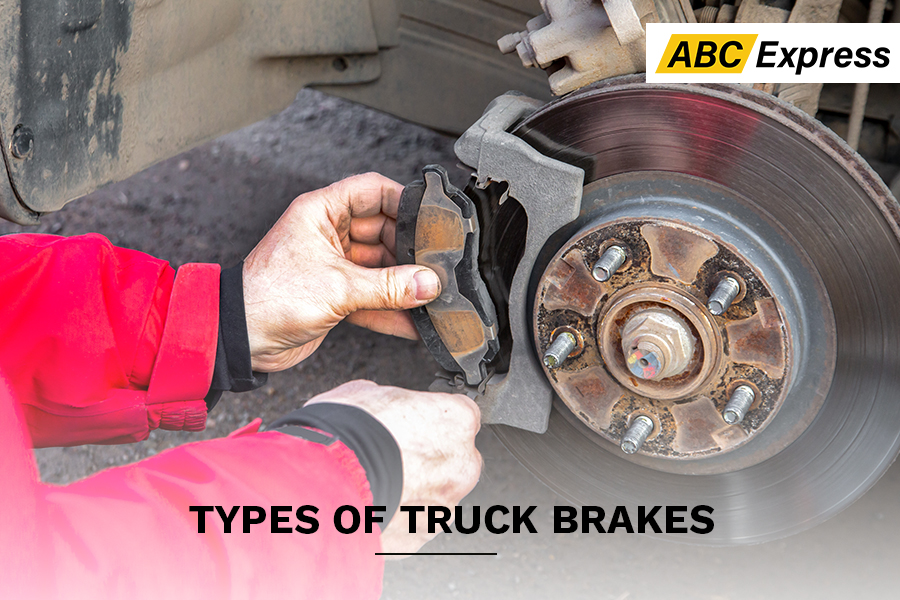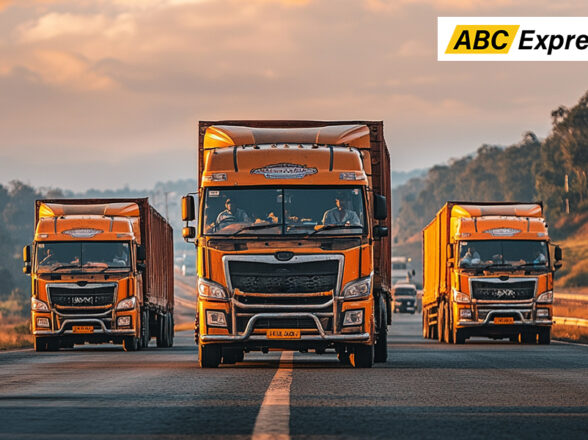
Introduction
Imagine a fully loaded truck speeding down a highway. Now, picture it needing to stop suddenly. What stands between a safe halt and a disaster? The truck brake system. At ABC Express, we’ve seen firsthand how the right brakes save lives, protect cargo, and keep logistics smooth. But with so many types of truck brakes available, how do you pick the best one?
This guide breaks down every braking system in simple terms used by Heavy Duty Trucks in India . Whether you’re a fleet manager, truck driver, or logistics pro, you’ll learn:
- How different types of truck brakes work?
- Why the air brakes vs hydraulic brakes debate matters?
- Which systems suit Indian trucks like Tata, Ashok Leyland, or BharatBenz.
- Tips to maintain heavy-duty truck brakes for long-term safety.
What Are Truck Brakes?
Truck brakes are heavy-duty versions of what you see in cars, but built to handle 10x more weight and stress. A typical truck braking system combines mechanical parts (like discs and drums) with air pressure, hydraulic fluid, or even computers to slow down massive vehicles.
Why Truck Brakes Are Different:
- Weight Matters: A loaded truck can weigh 40+ tons. Brakes must handle this without overheating.
- Long Distances: Trucks drive thousands of miles. Brakes need to last without constant repairs.
- Safety First: A brake failure isn’t just inconvenient—it’s deadly.
Fact: Commercial vehicle brakes are so critical that they’re regulated by strict safety standards worldwide.
6 Types of Truck Brakes –
Now, let’s explore the six main types of truck brakes in detail. We’ll cover pros, cons, and which Indian trucks use them.
1. Air Brakes
How They Work:
Air brakes use compressed air stored in tanks. When you press the brake pedal, air pushes pistons to clamp brake pads against drums or discs.
Pros:
- Powerful: Perfect for heavy-duty truck brakes (e.g., 18-wheelers).
- Safety: Air leaks? The brakes engage automatically.
- No Fluid Leaks: Uses air instead of hydraulic fluid.
Cons:
- Complex Repairs: Requires skilled mechanics.
- Moisture Issues: Tanks need regular draining to prevent rust.
Best For:
- Long-haul trucks (e.g., Tata Prima).
- Mountainous routes (Himachal, Uttarakhand).
- Trailers and multi-axle vehicles.
Their are so many Brands of truck & mostly Indian Brands Using Air Brakes:
Tata, Ashok Leyland, Eicher Pro.
2. Hydraulic Brakes
How They Work:
Hydraulic brakes use fluid to transfer pedal pressure to the brakes. Common in smaller trucks.
Pros:
- Smooth Control: Easier to modulate than air brakes.
- Low Maintenance: Fewer parts to replace.
Cons:
- Overheating: Fluid can boil on steep slopes.
- Not for Heavy Loads: Struggles with 10+ ton loads.
Best For:
- Delivery vans (e.g., Mahindra Furio).
- Short urban routes (Delhi, Mumbai).
- Light-duty trucks.
Indian Brands Using Hydraulic Brakes:
Mahindra, Force Motors.
3. Disc Brakes
How They Work:
A caliper squeezes brake pads against a spinning disc (rotor). Like a giant bicycle brake.
Pros:
- Weatherproof: Works great in rain (no water stuck in drums).
- Cooler Operation: Less brake fade on long drives.
Cons:
- Costly: Discs and pads are expensive to replace.
- Faster Wear: Pads need frequent checks.
Best For:
- High-speed trucks (e.g., Volvo FMX).
- Hilly terrain (Western Ghats).
- Modern fleets with safety budgets.
Indian Brands Using Disc Brakes:
ABC Trucks, Scania.
4. Drum Brakes
How They Work:
Brake shoes press outward against a rotating drum. Old-school but reliable.
Pros:
- Affordable: Cheaper to manufacture and repair.
- Durable: Handles heavy loads without wearing out fast.
Cons:
- Overheats: Poor heat dissipation on long descents.
- Wet Weather Issues: Water reduces friction.
Best For:
- Budget fleets.
- Older truck models (e.g., Ashok Leyland 1616).
- Rear-wheel braking systems.
Indian Brands Using Drum Brakes:
Ashok Leyland, Tata Signa.
5. Retarders (Auxiliary Brakes)
How They Work:
Retarders help slow the truck without using the main brakes. Types include:
- Exhaust Retarders: Block exhaust flow to create backpressure.
- Hydraulic Retarders: Use fluid resistance.
Pros:
- Saves Main Brakes: Reduces wear by 30-40%.
- Cooler Operation: Prevents overheating on slopes.
Cons:
- Extra Cost: Adds ₹2-5 lakhs to truck price.
- Weight: Adds 50-100 kg.
Best For:
- Mountainous regions (Leh-Ladakh).
- Heavy freight trucks (e.g., BharatBenz 4928R).
Indian Brands Using Retarders:
BharatBenz, Volvo.
6. Electronic Braking System (EBS)
How It Works:
EBS uses sensors and computers to control braking force. It’s like giving your truck a “smart brain”.
Pros:
- Faster Response: Stops 20% quicker than traditional brakes.
- ABS Integration: Prevents wheel lockups during panic stops.
Cons:
- Expensive: Adds ₹3-6 lakhs to the truck’s cost.
- Tech Dependency: Needs software updates and skilled mechanics.
Best For:
- Premium fleets (e.g., Amazon Logistics).
- Trucks with advanced safety needs.
Indian Brands Using EBS:
BharatBenz, Volvo, Scania.
Want to know, Check This Blog Now – Transport Rate Per Ton per Km
Common Truck Brake Configurations
Trucks use three main brake setups, each with a unique role:
1. Service Brake
- What It Does: Your everyday brake. Press the pedal, and the truck slows down.
- How It Works: Uses air brakes (compressed air) or hydraulic brakes (fluid pressure).
- Best For: Normal driving—stopping at signals, slowing in traffic, or merging lanes.
2. Parking Brake (Truck Hand Brake)
- What It Does: Keeps the truck stationary when parked. No rolling down hills!
- How It Works: Often a spring brake system. When air pressure drops (e.g., engine off), springs lock the wheels.
- Pro Tip: Always test your truck’s hand brake on a slight incline before relying on it.
3. Emergency Brake
- What It Does: Backup brakes that kick in if the main system fails.
- How It Works: Usually part of the parking brake. Some trucks have separate emergency valves.
- Real-Life Example: If air brakes leak pressure, the emergency spring brakes activate automatically.
Air Brakes vs Hydraulic Brakes: Detailed Comparison–
| Factor | Air Brakes | Hydraulic Brakes |
| Strength | Handles 40+ tons | Best for <10 tons |
| Cost | Higher initial cost | Cheaper upfront |
| Maintenance | Needs air tank draining | Fluid checks every 5,000 km |
| Safety | Auto-engages during leaks | Relies on fluid integrity |
| Best For | Tata, Ashok Leyland trucks | Mahindra, light-duty trucks |
How to Choose the Right Brake System for Your Truck?
- Know Your Truck’s Weight
- <10 tons: Hydraulic brakes.
- 10-40 tons: Air brakes + retarders.
- Consider Your Routes
- Hills/Mountains: Disc brakes + retarders.
- City Deliveries: Hydraulic or drum brakes.
- Budget
- Low-Cost: Drum brakes.
- High-Safety: EBS + disc brakes.
- Maintenance Skills
- Basic mechanics? Stick to hydraulic/drum brakes.
- Expert team? Invest in EBS or air brakes.
- Truck Brands in India
- Tata/Ashok Leyland: Great with air brakes.
Mahindra: Reliable hydraulic systems.
BharatBenz/Volvo: Top-tier EBS options.
- Tata/Ashok Leyland: Great with air brakes.
Brake Maintenance Tips for Fleet Managers–
- Air Brakes: Drain tanks weekly to prevent moisture buildup.
- Hydraulic Brakes: Check fluid levels every 5,000 km.
- Disc Brakes: Inspect pads every 15,000 km.
- EBS: Update software annually and train drivers.
Conclusion
Choosing the right types of truck brakes isn’t just about technology—it’s about safety, cost, and your truck’s daily grind. At ABC Express, we rely on robust truck braking systems to keep our deliveries on time and our drivers safe. Whether you’re driving a Tata through the Himalayas or a Mahindra in Mumbai traffic, the right brakes make all the difference.
Need fast and secure logistics? Contact ABC Express today.


